Insurance businesses are finally joining the trend: new insurance mobile apps are appearing more often today than a couple of years ago. Largely due to the benefits which mobile apps provide to insurance agencies: more satisfied customers, lower costs, and higher growth.
In this article, we go over the insurance app development process and, based on the Mind Studios experience, provide a reliable estimate for building your own insurance mobile app.
Why your insurance company needs a mobile app
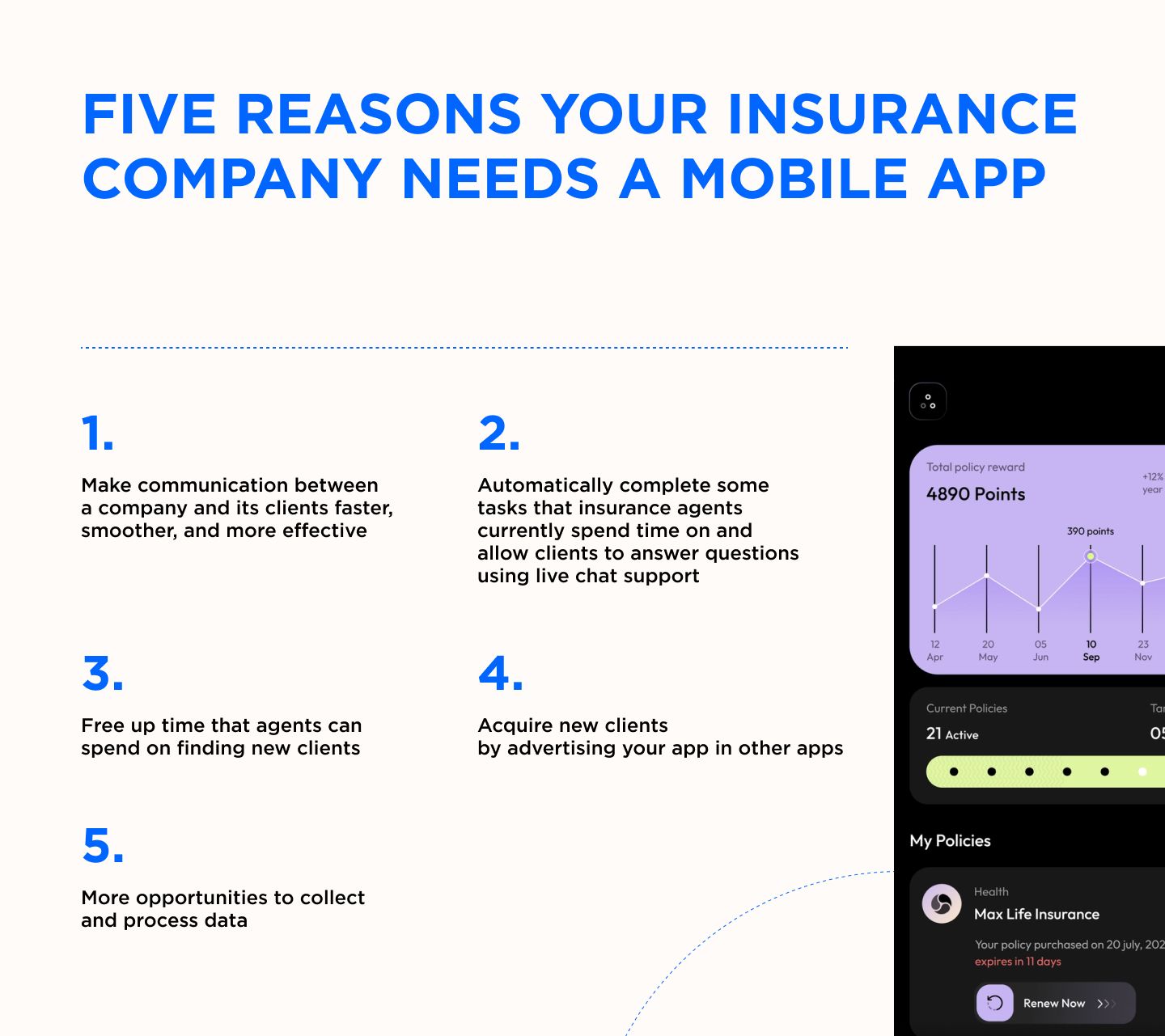
Mobile apps practically rule our lives today. Fun fact: We use our smartphones so much that our thumbs are changing the way they work. That’s already one good reason to make an insurance mobile app — to reach new, mobile-oriented clients.
But if you need some more specific reasons, here’s a list of perks an insurance app can provide:
- Make communication between a company and its clients faster, smoother, and more effective
- Automatically complete some tasks that insurance agents currently spend time on and allow clients to answer questions using live chat support
- Free up time that agents can spend on finding new clients
- Acquire new clients by advertising your app in other apps
- More opportunities to collect and process data
A well-made app lowers operational costs and increases revenue for an insurance company. For example, according to the McKinsey report, by digitalizing your insurance business, you can reduce the cost of a claims journey by as much as 30% and more than double your profits over the course of five years.
Insurance app market size & statistics
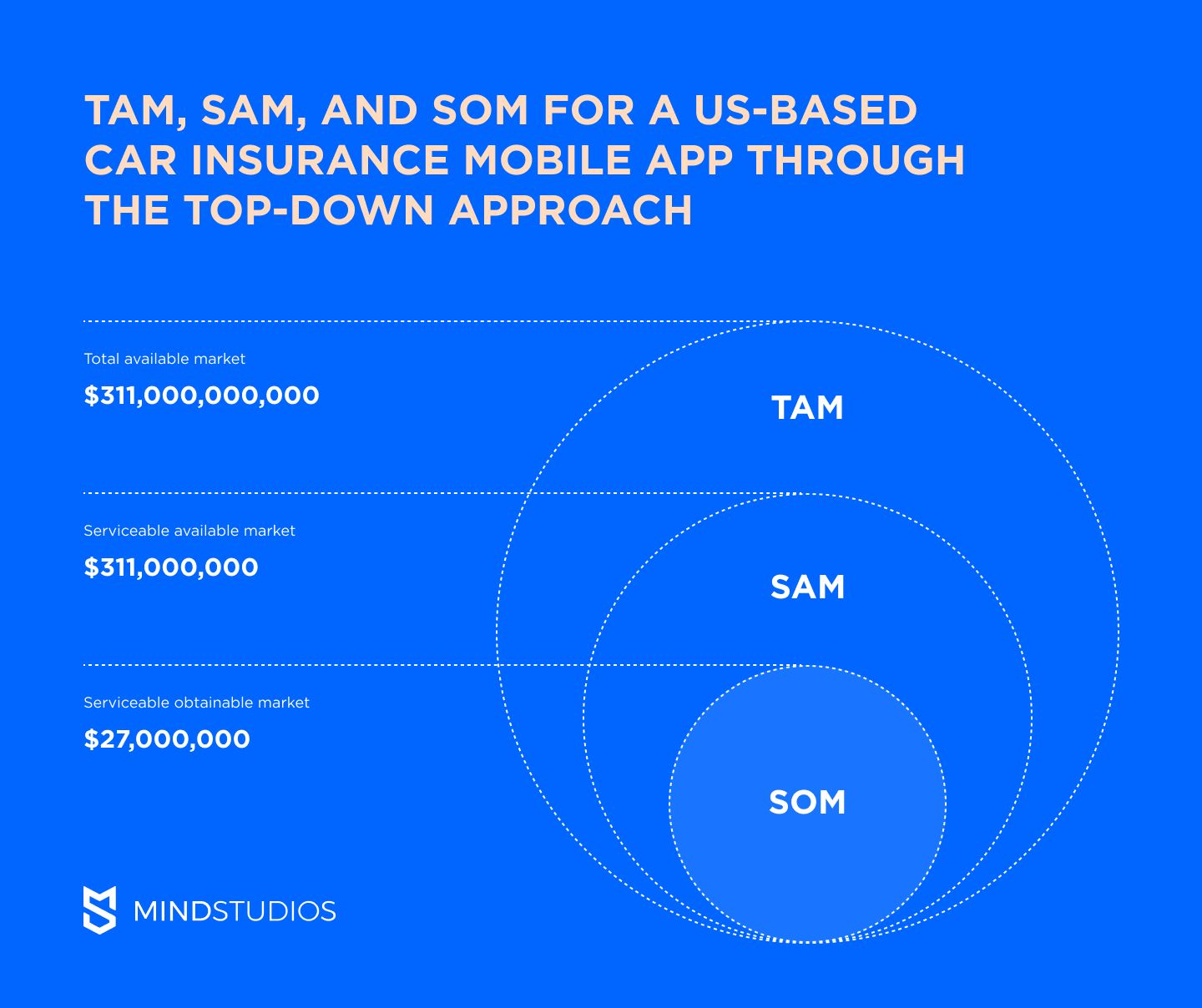
Before sketching your insurance mobile app’s first screens, it’s important to conduct thorough market research to make sure that your project’s prospects can meet your expectations, especially in terms of revenue.
One of the market research steps is to evaluate the potential of your total available market (TOM), serviceable available market (SAM), and serviceable obtainable market (SOM). Let’s derive these figures using a top-down approach.
Define your total available market
First, you need to figure out the general market size — this will be your TOM. For example, if you are a car insurance company operating in the US, your TOM will be equal to the overall automotive insurance market size in America in 2021 — $311 billion.
To make forward-looking calculations, you can explore some reliable market reports. For instance, experts from Globe News Wire say that the vehicle market will expand at a compound annual growth rate (CAGR) of 7.2% from 2022 to 2030.
Define your serviceable available market
Now, you need to define your SAM. If you operate in a particular state(s), you can find statistics about your state's share in the whole US vehicle insurance market size and get the numbers.
If you provide insurance services throughout the country, you can define your SAM by analyzing your competition volume. According to Forbes’ top 50 list, the largest ten auto insurance companies in the US take up 70% of the market, with State Farm (16.73%) as an undisputed leader. Safety Insurance and FEDNAT close the list both capturing 0.17% of the market share.
Based on your current insurance business scale and thorough competitor analysis, you will identify the market share you can capture. But even if we assume it’s 0.10%, your SAM will be as much as $311 million.
Define your serviceable obtainable market
Finally, you should define the SOM for your insurance mobile app project. And here, you can appeal to the data on your target users, specifically on the percentage of those who prefer to use mobile apps when it comes to insurance-related purchases.
According to the Q1 2022 Shopping LIST Report from J.D. Power, Millennials represent the largest group of shoppers (35%). Within this age group, 42% buy auto insurance online and 25% on mobile (data from Facebook IQ). Using this data, you can roughly estimate the potential your car insurance mobile app will bring to you.
If you take your SAM as $311 million, then $109 million out of those $311 million will come from Millennials’ purchases, including over $27 million in revenue coming from your mobile app.
Of course, these are approximate calculations, but even with them, you’ll be able to assess the potential of the market you plan to enter and understand whether you should invest in your mobile app project.
At Mind Studios, we pay extra attention to the discovery stage with different preparatory actions including market research, competitor analysis, and customer development. This helps us make data-driven decisions during development and lead our clients’ projects to success.
How to create your own insurance app
First of all, insurance businesses are pretty tricky when it comes to mobile applications.
Basically, insurance is a business with three main actors: the insurer (or insurance company), the insured (the person buying the insurance), and the providers of services covered by the insurance. For health insurance, the latter would be doctors and hospitals; for auto insurance, it would be car repair services.
Each party to this insurance circle will require its own app. Of course, you can build an insurance app for everyone where, upon registering, a user will choose a role. It’s not impossible. However, an app like that will have a couple of disadvantages:
- Choosing a role is one more step in the registration process. With the global move toward simplification and acceleration, the fewer steps a user needs to make, the better.
- A combo app will be about three times as big as each of its parts. It will require more space on a mobile device, more processing power, and more resources. And nobody likes heavy apps. You might need to sacrifice functionality to keep your app light.
On the other hand, with three connected but separate apps, you can add more insurance app features to each without making them bulky. So that’s our recommendation: If you make an insurance mobile app, make three instead of one. It’ll be worth the hassle.
If you can’t or don’t want to build three apps, you can actually build two — one for clients and another for your employees. By skipping a separate app for service providers, you’ll cut the cost of app development. However, you’ll then be leaving the task of dealing with service providers to your agents. An app can help reduce paperwork and the number of calls.
Another option for simplification is making a web app for your employees where they can promptly react to clients’ inquiries. This option is a bit less convenient if your insurance agents work on foot a lot. For those mainly operating from the office, though, it’s a valid option.
We’d like to discuss the client app now.
Types of mobile insurance apps
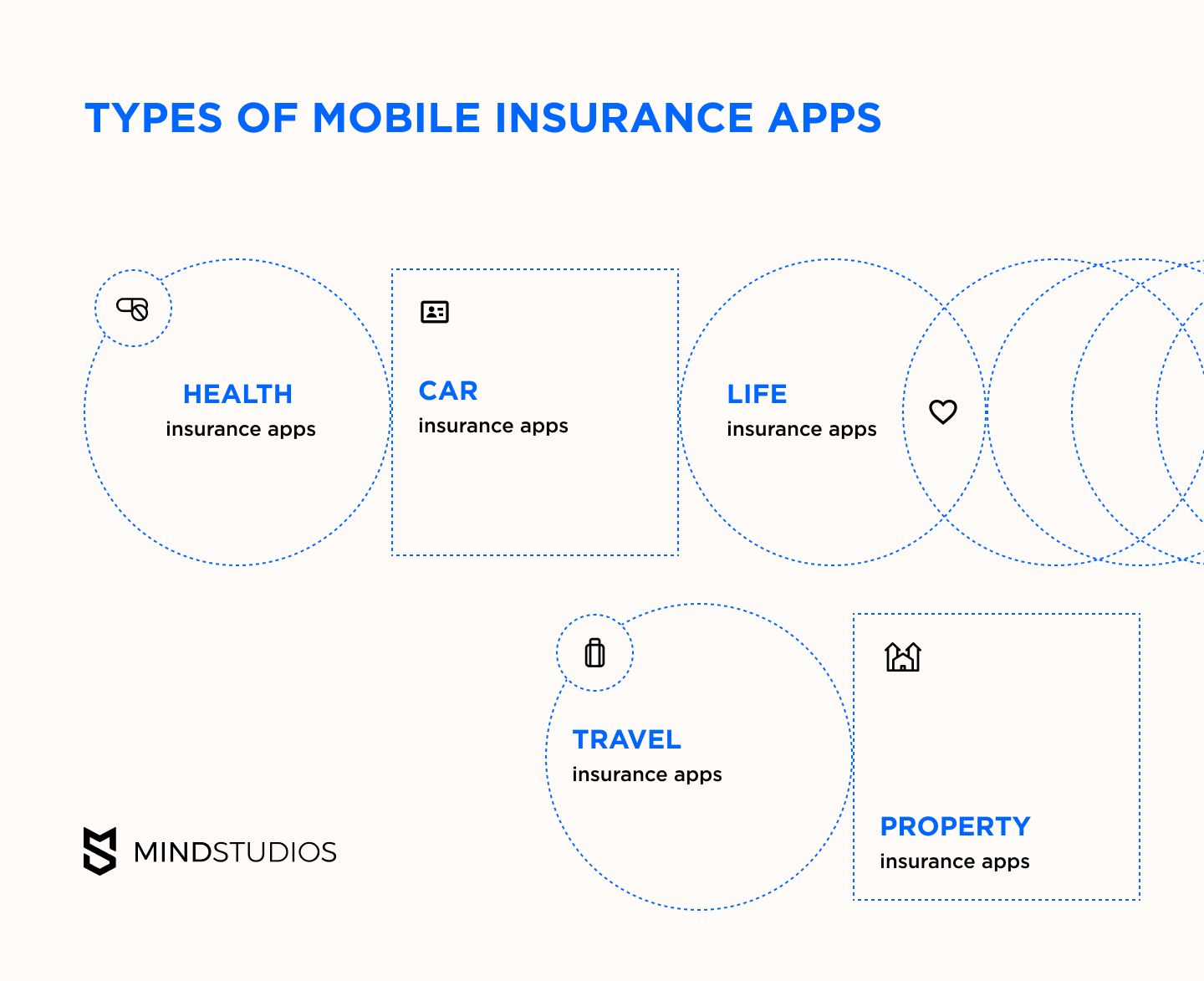
People insure all kinds of things, some of them funny and even pretty weird. Like insurance against a comedy show’s spectators dying from laughter. We might or might not have rolled on the floor laughing.
So what we’re trying to say here is that mobile apps will vary depending on the niche your insurance company operates in.
- Health insurance apps
- Car insurance apps
- Life insurance apps
- Travel insurance apps
- Property insurance apps
Features you’ll need to implement will heavily depend on your type of insurance business. At the same time, regardless of the part of the insurance industry your company operates in — life, health, property, or car insurance — the basic set of features in a mobile app will be similar.
There will be niche-specific features, but the core features are generally the same. Let’s start with them.
General features for any type of insurance app
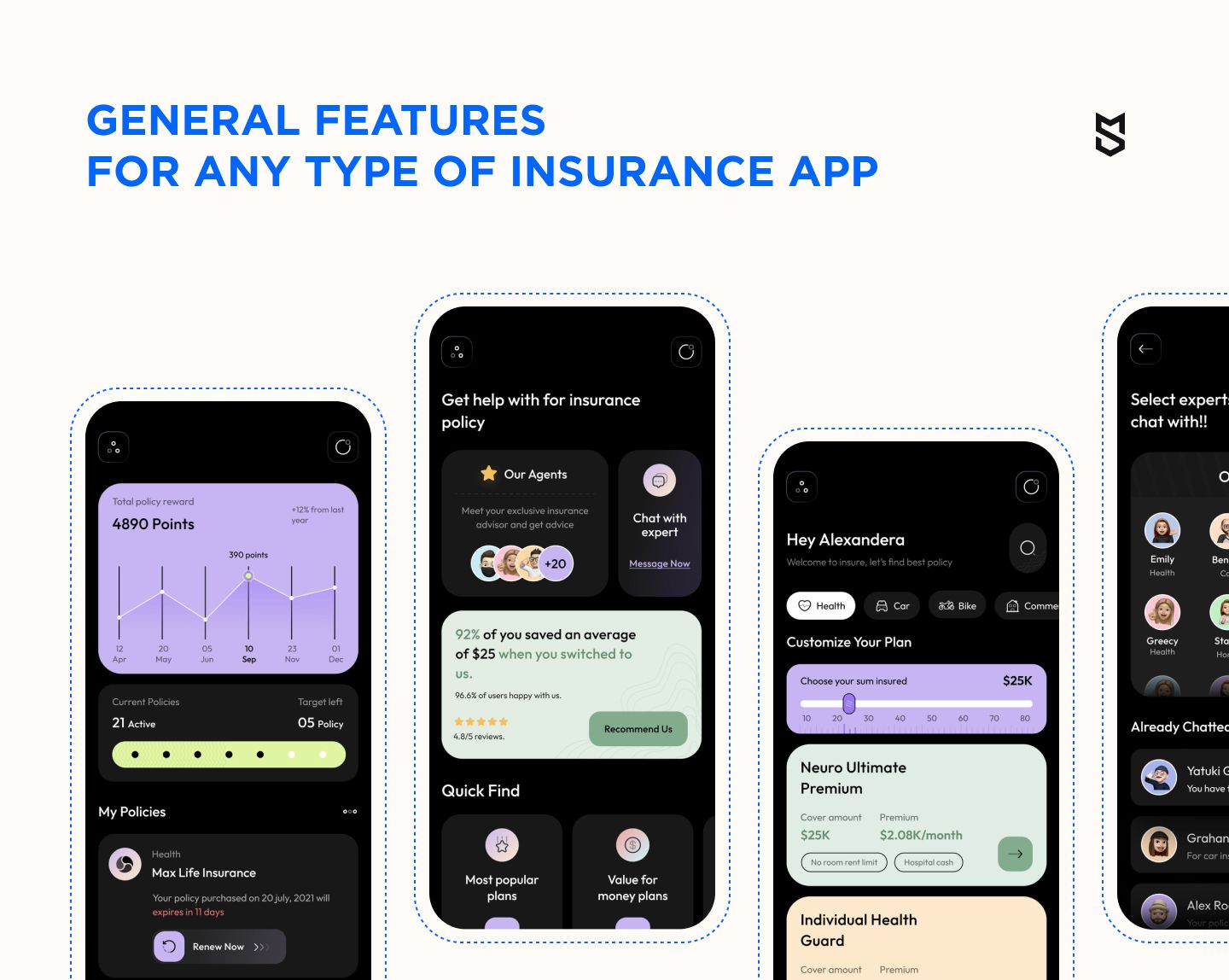
Profile
A profile is a screen where information about the insured object or person is displayed. If yours is a life or health insurance app, a profile will show information about the insured individual; if it’s a car insurance app, vehicle data will be displayed on the profile screen along with basic data about the owner.
Policy details
Instead of (or in addition to) a printed insurance policy, a digital version should be available in the app. Clients should be able to check it whenever they need.
All policies/find a policy
Whether or not you allow clients to choose a new policy or switch from an old one without visiting your company’s physical office, it’s important to offer clients an opportunity to browse all options at a convenient time. Say, at home when they’re relaxing after a day’s work.
Clients should be able to search for policies by selected parameters, especially if your insurance company offers a wide range of options.
Finally, users will most certainly appreciate tailored recommendations — policies that suit them best according to their income, health, property, family members, etc. Depending on what customers are insuring, the necessary data will vary. But an automated selection of policies will surely be valued.
Quotes
To offer a policy, a company usually needs certain information about the customer. However, if you’ve got a screen in your app that lists different policies with quotes, it will help your customers assess their options.
File a claim
This is the feature most clients download insurance apps for. It’s the reason for developing your insurance application, so to speak. Filing a claim in case an insured event occurs must be intuitive and easy. Otherwise, there’s little to no point in the app. Especially in cases like car accidents or house robberies, where everything should be dealt with quickly and efficiently.
A client should be able to enter all necessary information efficiently, preferably on a single screen. It would be a bonus if you allowed users to take photos right from the app. This feature will come in handy for car and property insurance.
Alternatively, customers can take photos with their phone’s default camera app and upload them in the app to file a claim.
Payment processing
By integrating a payment gateway into your mobile app, you free clients’ time. With in-app payments, there’s no need for a client to go to the bank or even open a banking app and fill in policy details; they don’t need to make another step and go to your company website to pay. This makes for a better user experience: just tap a couple of times to make a payment right after choosing an insurance policy.
To make it even better, you can allow users to set up automatic payments.
Customer support
Live 24/7 support via integrated chat isn’t much of an innovation in the insurance industry. Clients can have car accidents at any time of the day. Actually, nighttime accidents are more common. Besides, some people work odd hours. Questions can pop up around the clock.
If you’ve got staff to answer those questions at any time, it’s a big benefit in the eyes of clients. It’s also possible to implement in-app calling functionality, or at least the ability to request a call from a support specialist. This feature will add points to your app’s karma.
Notifications
Customers like to know how the claim processing is going. Or if you’re offering any limited-time discounts. They also like to get notified about approaching payments so they don’t find themselves in an accident without any active insurance. Push notifications are probably the most efficient way to reach people today.
Chatbots/AI
Artificial intelligence-powered chatbots are trending this year. The insurance industry can benefit from them just as much as any other industry, if not more. AI can improve and speed up identity verification, personalize interactions between apps and clients, facilitate claims settlement, and help prevent fraud.
Document/image uploading
The ability to upload a photo of a car post-accident or medical records can enhance claims processing, policy recommendations, and so on.
Insurer app development
For your employees, you can either make a mobile or a web app. If you have an office where insurance agents usually work, a web admin panel might be enough. Insurance apps for agents are necessary for insurers who need an intuitive way to work on a smartphone or tablet.
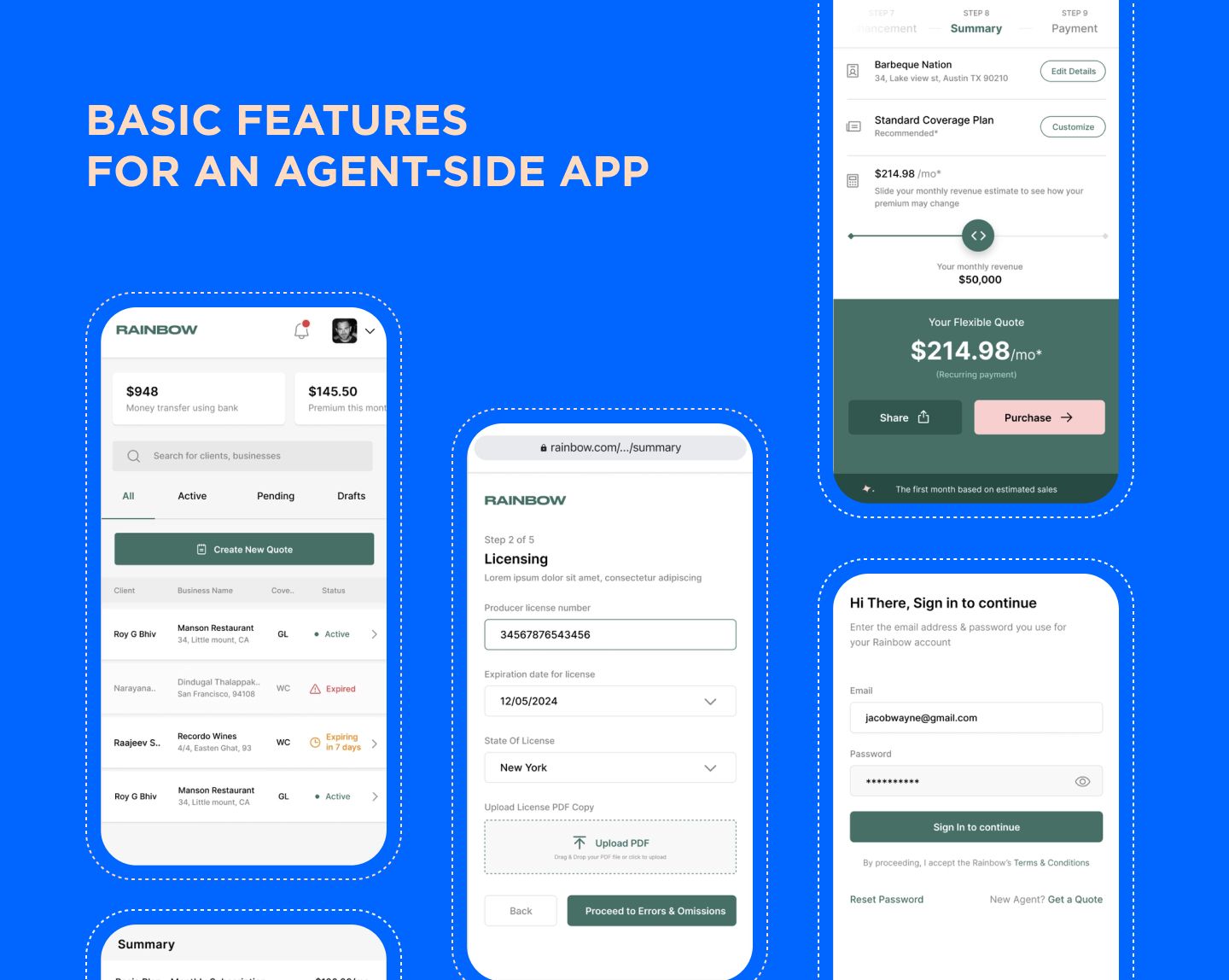
However, agents also need a list of all their clients, along with detailed profiles with all the data clients provide when they buy a policy. All documented behavior of clients also goes here, like all claims and how they were settled, all activities your company deems important for processing, etc.
Admin panel
You might need to monitor your employees, right? If you decide to make an insurance mobile app for your agents, you’ll need an admin panel for yourself with data on both agents and customers. If you make a web admin panel for employees, you can have your own admin profile with more permissions to manage agents. It will show you the data other agents can’t access.
Note: There’s a lot of sensitive data involved in buying and maintaining insurance. Hence, when you build a mobile insurance app, you need to invest in the latest security certificates and data protection.
Industry-specific features
Depending on what kind of insurance business you have, you’ll need to add features to meet your target audience’s specific needs.
A car insurance app needs:
- Geolocation for clients to easily notify the insurer where they are in case of an accident
- Integration with Google Maps (or any other mapping service you find suitable) to show the location of mechanics, gas stations, and related services
- An AI motion sensor that records driving behavior — Based on this data, your company might offer discounts to careful drivers to promote safe driving (so-called telematics-powered auto insurance)
A health insurance app needs:
- Search for doctors and the ability to contact them
- The ability to book appointments, including an integrated calendar with notifications
- A symptom checker so patients can decide which doctor to see
- If your insurance company covers prescription drugs, a pharmacy search would be a winning feature.
Other industries will have their own necessary features, of course; you probably know the needs of your clients better than anyone. Additionally, a designated project manager in an app development company should be able to help you with research and prioritizing necessary app features.
Technologies used to create insurance applications
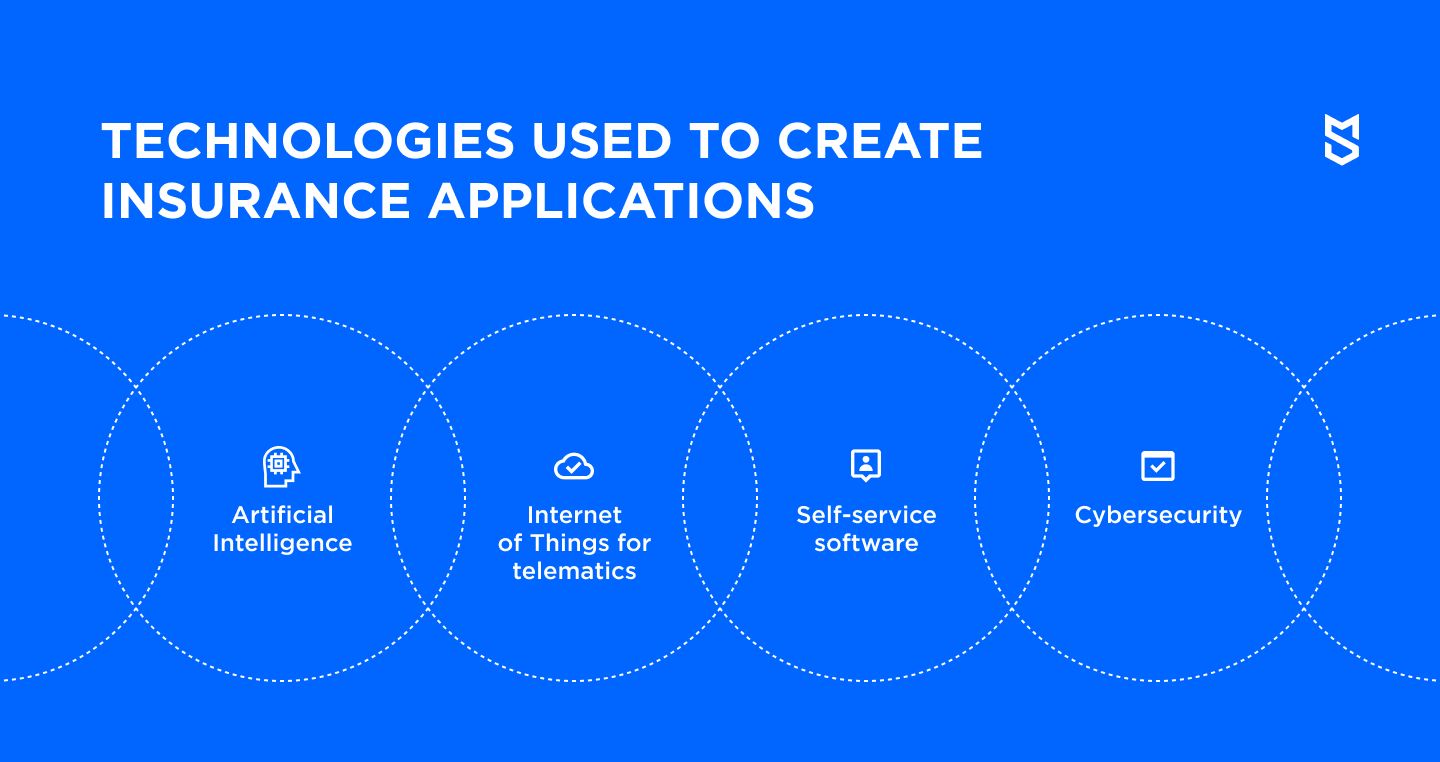
After you launch an MVP, your development team will start to systematically collect user feedback and monitor key performance indicators. Based on this data, you’ll be able to define the right vector for improving your app and enriching it with tech-savvy functionality.
Here, we’ll provide you with a brief overview of the most commonly used technologies in insurance application development that could add a cherry to your cake.
Artificial Intelligence
This technology is highly used by insurtech companies to import and collect massive amounts of consumer data to assess risks, improve claims turnaround cycles, and automate underwriting procedures. AI-powered tools help insurers create a more personalized experience, provide faster user verification, and detect fraud.
For example, by implementing machine learning, a Chinese insurance company Ping An achieved a 57% increase in accuracy in detecting fraudulent claims in one year which resulted in $302 million in savings.
IoT for telematics
Today, consumers are more willing to share significant data on their health, exercise and driver habits to get personalized insurance offers and reduce rates. Insurers can collect this data from the Internet of Things (IoT) sensors that are integrated into smart homes, wearable devices, and vehicles.
In terms of car insurance, for instance, the IoT technology enables insurers to offer clients two kinds of telematics programs: pay-as-you-drive which bases rates on the number of miles taken, and behavior-based which reduces insurance rates if you drive safely and eco-friendly.
More so, telematics tools help insurance companies lower accident rates and therefore, keep afloat. For example, Traffilog, a web-based fleet-management provider, claims that by using their IoT-backed technology, insurers can decrease the accident rate by 5% and double their profit.
Self-service
The pandemic facilitated shifting to digital communication tools between insurers and insureds. As of January 2020, life insurance agents made 90% of sales communications with clients in person. In May, this figure dropped to below 5%. Meanwhile, there has been a surge in client demand for self-service insurance solutions, and still growing.
State Farm, one of the largest life insurance providers in the US, caught that trend with its virtual self-service portal, enabling consumers to buy life insurance policies without passing a medical exam. As a result, it ranked highest among other individual life insurance companies in 2021, with a score of 822 out of 1,000 possible points.
Cybersecurity
Insurance business always strives to be risk-averse. However, when it comes to developing a mobile app, it often initiates a string of experiments that could partly or entirely transform established business processes. So how to change safely and retain customers' trust?
One of our recommendations is to make an insurance app as secure as possible. Cybersecurity technologies must be baked into your insurance app since it will store clients’ most sensitive data including personally identifiable information (PII), social security number (SNN), driver's license, credit cards, medical records, tests, etc.
To protect users from ransomware attacks, identity thefts, and cyber frauds, you can equip your insurance app with the following cybersecurity tools:
- Regulations and legalities
- Multi-factor authentication
- Cloud encryption
- Defensive artificial intelligence
- Context-aware security
- Behavioral analytics
- Manufacturer usage description
- Extended detection and response
- Zero Trust
- Blockchain
Tech stack for insurance mobile app development
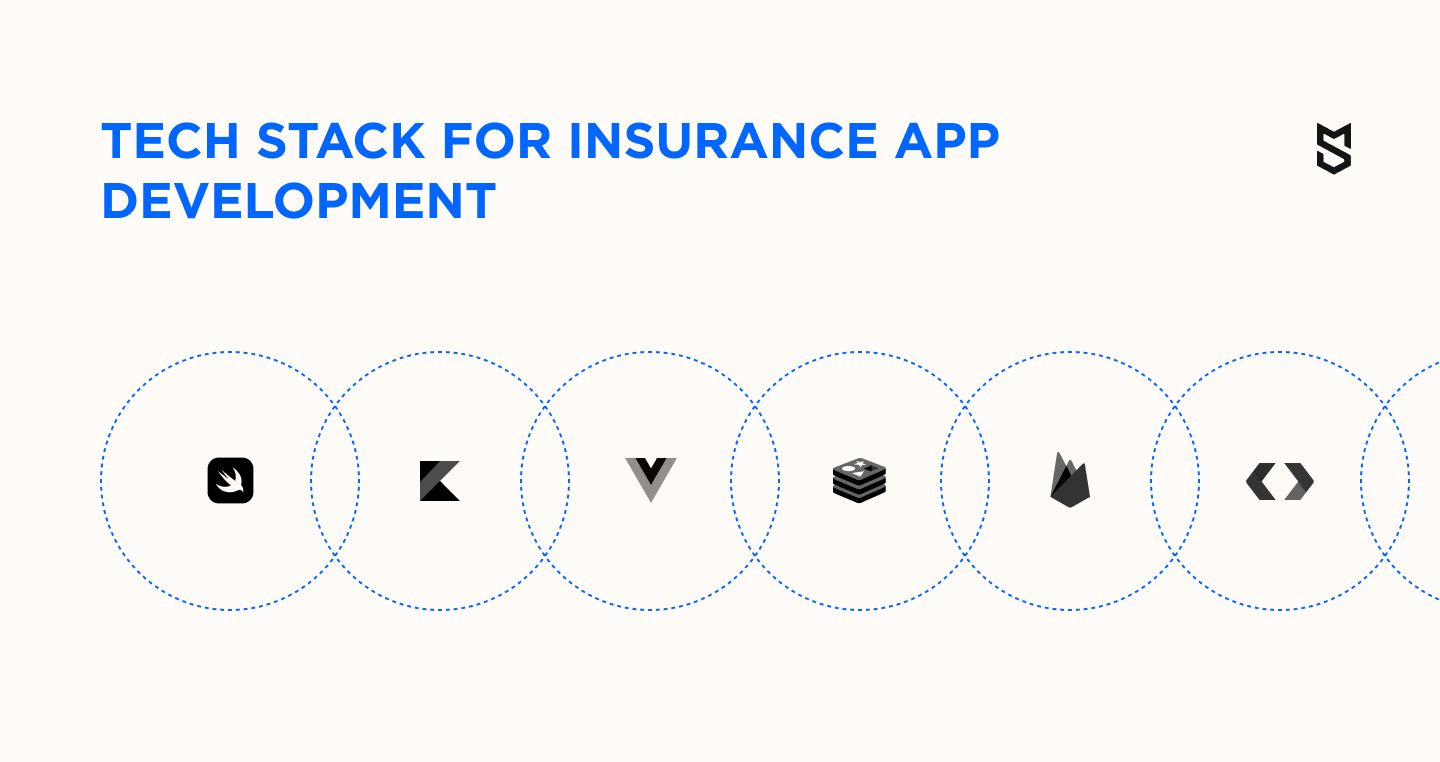
Apart from above-described advanced technologies used to develop an app for an insurance agency, there is also a technology stack regarding predominantly the backend part of the development process we’d like to share with you.
The table below contains tools our developers recommend to use for servers, hosting, storage, database, payment gateway, and more.
| Type of work | Technology |
|---|---|
| Android development | Kotlin |
| iOS development | Swift |
| Cross-platform development | React Native |
| Backend | Ruby, Node.js |
| Backend frameworks and libraries | Ruby on Rails (Ruby), Express/Nest.js (Node.js), Bootstrap (Admin panel UI) |
| Databases | Amazon RDS |
| File storage | Amazon S3 |
| Caching | OVH CDN, CloudFront |
| Hosting | AWS, OVH |
| Multi-factor authentication | Twilio Authy |
| Payment gateway | Stripe, PayPal |
What is better to create: a mobile or web insurance app first?
The answer is it depends. If your agents predominantly work from an office, they’ll appreciate your web insurance app. More so, a web app for your employees will be convenient in case you have a lot of papers stored in PDF formats.
One more advantage of a web insurance app is that its development is cheaper than building an insurance mobile app from scratch. But all these pros are related to your agents, not clients.
As for your target customers, the major part of them are Millennials. According to Pew Research Center, 19% of Millennials are mobile-only internet users. In terms of usability, a mobile app has an undisputed advantage — it is always available from anywhere, anytime.
What’s more, a mobile insurance app has extra marketing channels and can deliver personalized and timely content through push notifications.
So when it’s hard for our clients to determine the course of their insurance application development at once, we at Mind Studios often resort to the discovery stage. It includes thorough market research, competitor and target user analysis, and initial unit economics calculation.
Only after the discovery stage is completed, we're able to make recommendations that will help our client make data-driven decisions.
Cost to develop a mobile app for an insurance company
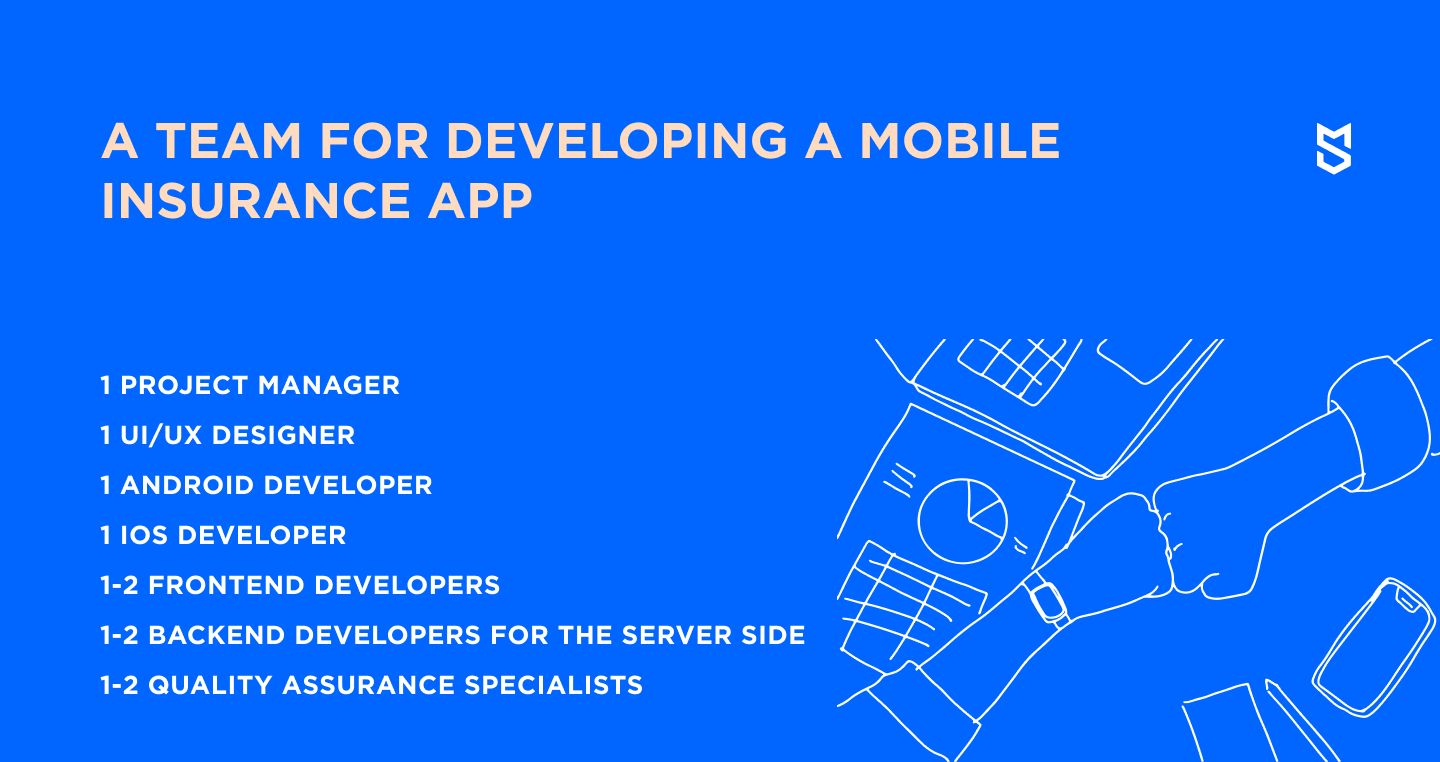
At Mind Studios, we always recommend our clients start with developing a minimum viable product (MVP). This helps them launch faster with a somewhat abridged app. An MVP is a great way to get your first users, too. And developing an MVP is, of course, cheaper than making a full app from the get-go.
If you decide to go for both iOS and Android insurance app development, the cost of an MVP will start at about $120,000 and will go up as you add insurance mobile app features. In terms of time, it will take you 5 – 6 months to get your MVP ready.
See the breakdown of the insurance app development cost in the table below:
| Stage | Time, h | Cost, USD |
|---|---|---|
| Business analysis and market research | 80+ | 3,600 |
| Prototyping and UI/UX design | 220 | 9,900 |
| iOS development | 560 | 25,200 |
| Android development | 560 | 25,200 |
| Backend development | 680 | 30,600 |
| Project management | 280 | 12,600 |
| Testing | 320 | 14,400 |
| Total | 2,700 | 121,500 |
Insurance apps for agents cost approximately the same or slightly less, and web apps are generally easier and cheaper to build than mobile apps. We can provide a general insurance app development estimate with more precise values upon request. Just leave a message on our contact us page.
Final word
An insurance mobile app is no longer a “wow factor”. If you wonder how to create a successful app for your insurance agency, think of making it an end-to-end solution. Your app should guide your customers from the start of buying a new policy or requesting a claim right onto requests' completion through several taps on their smartphone screens.
With the right mobile app development team, you’ll be able to slice and dice all possible app usage scenarios and create a clear and comprehensive roadmap for your mobile insurance app. This, in turn, will allow you to make an insurance app that will meet your customers’ needs, win their long-term loyalty, and reward you with a fast return on investment.
Sounds great, doesn’t it? So does the voice of our business development consultant :) Feel free to check it out.


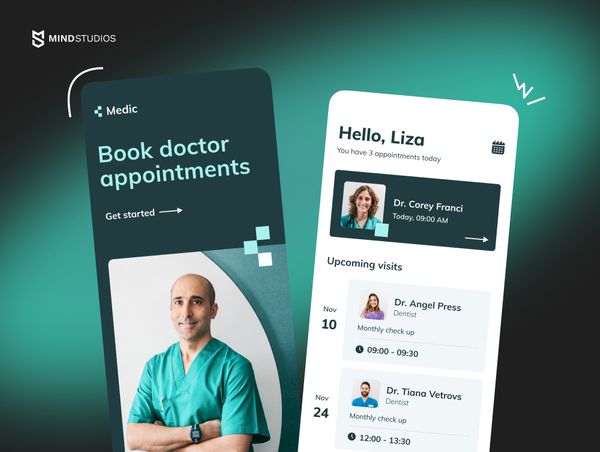
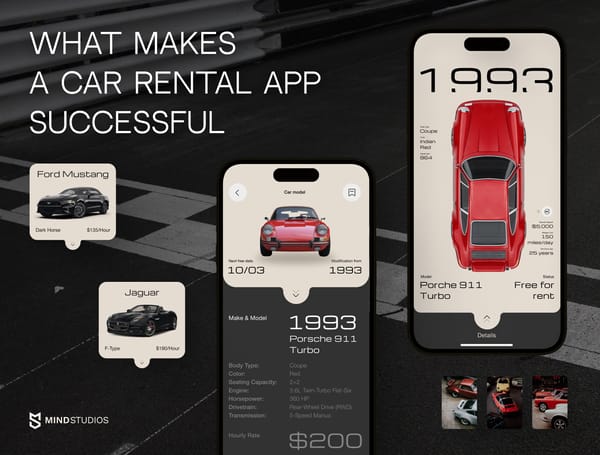
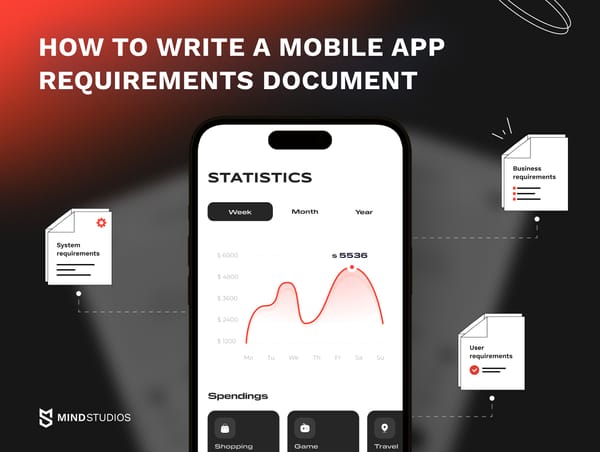
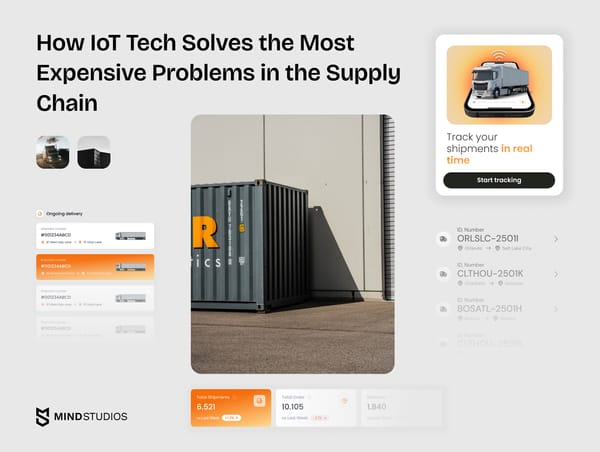
![How to Create an On-Demand Medicine Delivery App [Expert Guide]](https://themindstudios.com/blog/content/images/size/w600/2025/03/IMG-1-Cover-6.jpg)

